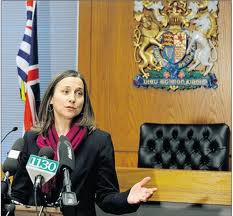Johnson Landing recovery mission put on hold as search team determines next move
The BC Coroners Service has decided to take a step back and reassess the recovery mission at Johnson Landing said Chief Coroner Lisa Lapointe Wednesday during a media scrum at the Kaslo Arena.
The decision comes following the second day the search team did not locate any of the two remaining missing bodies from Thursday’s massive mudslide that devastated three houses in Johnson Landing.
“What we’re going to do now is reassess if we could potentially find more victims,” Lapointe told the media.
“Where could we potentially find other victims?
“Will it be safe to work in those areas and how could we make it safe.”
Lapointe said the search team concluded Phase one of the recovery mission Wednesday, which was searching the area we believed most likely to find the victims of the slide.
Those areas included immediate areas surrounding the properties.
Crews used excavators to search around those areas, in some cases that was digging and removing approximately five metres of debris.
“We felt the best chance to find additional bodies was near foundations of house destroyed in the slide,” Lapointe said.
Sunday, the BC Coroners changed the focus of the mission from rescue to recovery after finding a body believed to be that of 60-year-old Valentine Webber.
Monday, the body of a young woman was located under the debris field, in as much as 10 metres of nearly rock-hard mud.
The body is believed the remains of either 17-year-old Rachel Webber or her 22-year-old sister, Diana.
The other body crews are searching the debris field is that of German visitor Petra Frehse, 64.
Lapointe said a reason to step back is out of concern for safety of the search team, which numbers 24.
“The area remains unstable,” Lapointe exclaimed, noting the public should stay out of the slide area for some time. “It is very dangerous.”
“We do have a number of safety precautions in place to those who have been searching on the hill and are very, very fortunate we have not had an incident on the hill,” she added.
Lapointe gave no time frame on when the search for the missing bodies would continue.
The various parties, including Kaslo Search and Rescue, HUSAR (Heavy Urban Search and Rescue) Canada Task Force I from Vancouver and the RCMP, to name a few, would all have input as to what the next step.
When asked by media if the missing bodies might never be recovered, Lapointe answered: “I think we have to consider there is the potential that we may never locate the other two victims.”
“We will try to make the determination what are the most likely areas we may find more victims and we’ll make some assessment as to how we can recover them safely but, of course, there are no guarantees,” Lapointe continued.
“We might excavate several more tons of earth and may not find them.”
The Regional District of Central Kootenay Emergency Operations Centre held a meeting with Johnson Landing residents Wednesday to discuss the status of the slide.
At this point, the area remains off limits to the public said Dawn Attorp EOC director for the RDCK as the slide that measures 83 acres — 2,000 metres long, 100-200 metres wide — is at least three to five metres deep.
And, until a geotechnical assessment gives residents the green light, the area is off limits.
“We will search where we think we will most likely find them and if we don’t, at some point, we all recognize we can’t excavate the whole slide,” Lapointe concluded.


























Comments